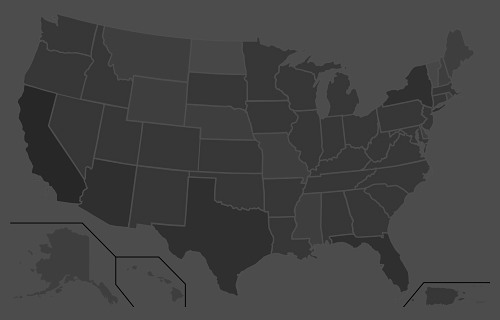“Our added winter moisture and active calling period led to a very long nesting and hatching season, starting in late April and extending into early summer, with chicks hatching as late as early July,” O’Dell said. “From a population standpoint, we are out of a deficit for the first time since 2001-2002. Quail are starting to pop up in places they haven’t been seen in a while.
“If you’ve never had the chance to experience what Arizona quail hunting built its name on, then this would be the year to get out and enjoy it.”
Meanwhile, hunters should note that the season for Mearns’ quail doesn’t begin until Dec. 4. It’s summer rainfall that plays a key role in nesting success and population numbers of this species. After a spotty and relatively weak monsoon across southern Arizona, these birds are likely to be abundant only in pockets that received sufficient precipitation this summer.
A valid Arizona hunting or combination hunt and fish license is required for all hunters 10 and older. Those hunters under 10 must either have a valid hunting or combination hunt and fish license, or be accompanied by an adult who possesses a valid hunting or combination hunt and fish license. Licenses can be purchased online or at license dealers statewide. A youth combination hunt and fish license (ages 10 to 17) is $5.
The general bag limit is 15 quail per day in the aggregate, of which no more than eight may be Mearns’ quail (when the Mearns’ season opens Dec. 4). The general possession limit is 45 quail in the aggregate after opening day, of which no more than 15 Gambel’s, scaled or California quail in the aggregate may be taken in any one day. After the opening of the Mearns’ season, the 45-quail possession limit may include 24 Mearns’ quail, of which no more than eight may be taken in any one day.
More quail-hunting information can be found on the department’s website at https://www.azgfd.com/Hunting/. Another resource for both new and experienced hunters alike is “An Introduction to Hunting Arizona’s Small Game.” Written by Randall D. Babb, the 196-page, full-color book covers where and how to hunt small game birds (like quail), squirrels, rabbits, ducks and geese. It also includes how to prepare and cook your harvest, with illustrations and recipes. The book can be ordered for $16.95 at www.azgfd.gov/publications.
Finally, hunters should check out O’Dell’s techniques for field-dressing quail at https://www.youtube.com/watch?v=3gRwZAcWzzk.
####
Publishers Notes: OUT OF STATE HUNTERS, FISHERMEN & OUTDOOR ENTHUSIASTS; Due to the Covid 19 pandemic, there could be limitations for OUT of STATE hunters, fishermen and other outdoor enthusiasts to include a 14-day quarantine requirement or negative COVID-19 testing alternative. Please check with the State's Department of Natural Resources BEFORE you travel or apply for the 2020 Fall Hunts.
Disclaimer: The views expressed on this site are that of the authors and not necessarily that of TBC Press
CDFW Special Post-Season Waterfowl Hunt Weekend for Vets & Active Military Feb 13-14, 2021
Submitted by: TBC Press
Posted on: 02/05/21
The Backcountry Press
The country's premier daily HUNTING, FISHING & OUTDOOR news in the USA and around the globe. Read whats happening in your neck of the woods & beyond.
© 2020 TBC Press - All Rights Reserved Website Design by:
News # 14200
Among those public areas reopening for Veterans and Active Military Waterfowl Hunting Days: The Little Dry Creek Unit of the Upper Butte Basin Wildlife Area, Colusa National Wildlife Refuge, Delevan National Wildlife Refuge, Sacramento National Wildlife Refuge, Sutter National Wildlife Refuge, Grizzly Island Wildlife Area, Gray Lodge Wildlife Area, Kern National Wildlife Refuge, Los Banos Wildlife Area, Mendota Wildlife Area, Merced National Wildlife Refuge, San Luis National Wildlife Refuge, North Grasslands Wildlife Area, San Jacinto Wildlife Area, Volta Wildlife Area, Wister Unit of the Imperial Wildlife Area and Yolo Bypass Wildlife Area.
A wildlife area pass is required to hunt on Type A and Type B state-operated wildlife areas and national wildlife refuges during the hunt weekend. These items are not available for sale at hunter check stations and must be purchased ahead of time. All 2020 Type A and Type B Wildlife Area Season Passes and Type A One and Two-Day Wildlife Area Passes will be accepted during the hunt weekend. A Type A or Type B Season Pass is required to hunt on Type B Wildlife Areas.
As of Feb. 1, overnight camping is once again allowed on state-operated wildlife areas and federal refuges reopening for the Youth Waterfowl Hunting Days Feb. 6-7 and the Veterans and Active Military Waterfowl Hunting Days Feb. 13-14. Please check with the individual property for entry procedures, specific details and other regulations.
Waterfowl hunters are strongly encouraged to review the 2020 CDFW Wildlife Area Operational Changes due to COVID-19 webpage prior to visiting any state-operated wildlife area or refuge in order to understand all required health and safety practices in place to help protect visitors and staff. Waterfowl hunters are further advised to check with the individual property they are planning to hunt for specific entry procedures, details and other regulations.
Below are general COVID-19 safety guidelines to reduce the risk of exposure to the virus in the outdoors:
- Stay Local: Stay close to home during this pandemic period. If you or anyone in your household is feeling sick, please remain at home and plan your trip for another time.
- Plan Ahead: The ongoing pandemic response continues to be dynamic. Prior to leaving home, check to ensure your destination is open, if parking is available and what visitor guidelines may be in effect.
- Stay Safer at Six Feet: No matter the recreational activity, maintain a physical distance of six feet or more. Those camping together should only include people within your immediate household. This means no guests or friends, and no gatherings or parties.
- Keep Clean: Be prepared as not all services may be available. Restrooms may be unavailable or closed. Bring soap/hand sanitizer. Please pack out all trash.
- Stay Covered: The state requires you to wear a face covering when you cannot maintain a physical distance of six feet or more. Individuals must have a face covering with them at all times.
####
Publishers Notes: Our country is still battling COVID-19. To avoid the spread of this virus and continue to enjoy outdoor activities, ALL outdoor enthusiasts (man, woman, child) should follow the guidelines set by nps.gov. These guidelines include; social distancing, the Leave No Trace principles, including pack-in and pack-out, to keep outdoor spaces safe and healthy.
The California Department of Fish and Wildlife (CDFW) will reopen and staff nearly two dozen of the state’s most popular waterfowl hunting areas to welcome veterans and active military personnel for a special hunt weekend Feb. 13 and 14.
The first Veterans and Active Military Waterfowl Hunting Days take place the second weekend in February throughout the Balance of the State, Southern San Joaquin Valley, and Southern California waterfowl zones on both private property and public land for eligible hunters.
Species and daily bag limits are the same as the regular season with the following exceptions: Brant are not open to take and geese are not allowed to be taken in the Balance of State Zone on these days.
In addition to a valid California hunting license, California duck validation, federal duck stamp and Harvest Information Program (HIP) validation, any person participating in these hunts must possess and present upon demand verification of eligibility. Acceptable verification includes: a Veteran ID Card, military ID card for active duty personnel, or a state-issued driver license or ID card with veteran designation. Qualifying veterans are those defined in Section 101, Title 38, of the United States Code. Absence of verification may subject the hunter to citation.












